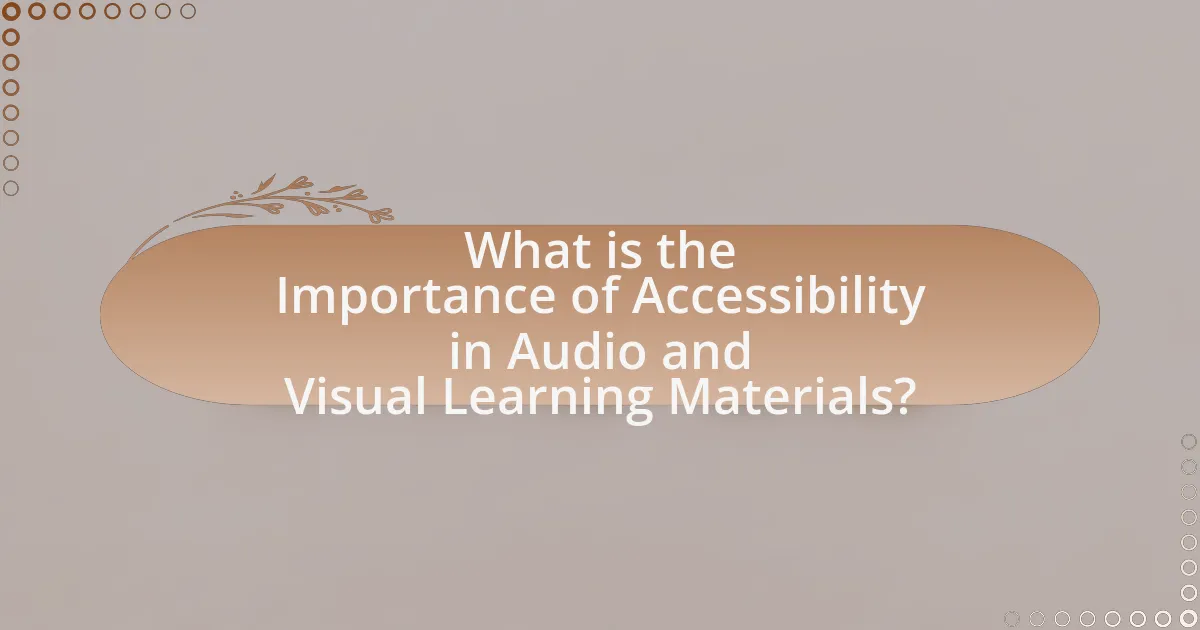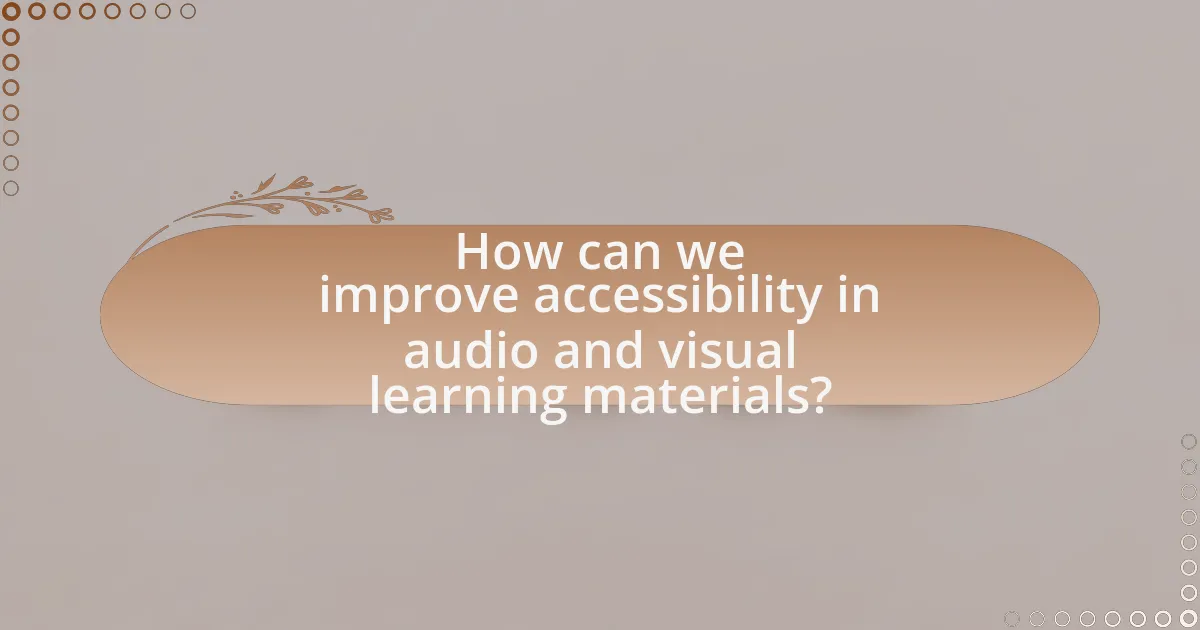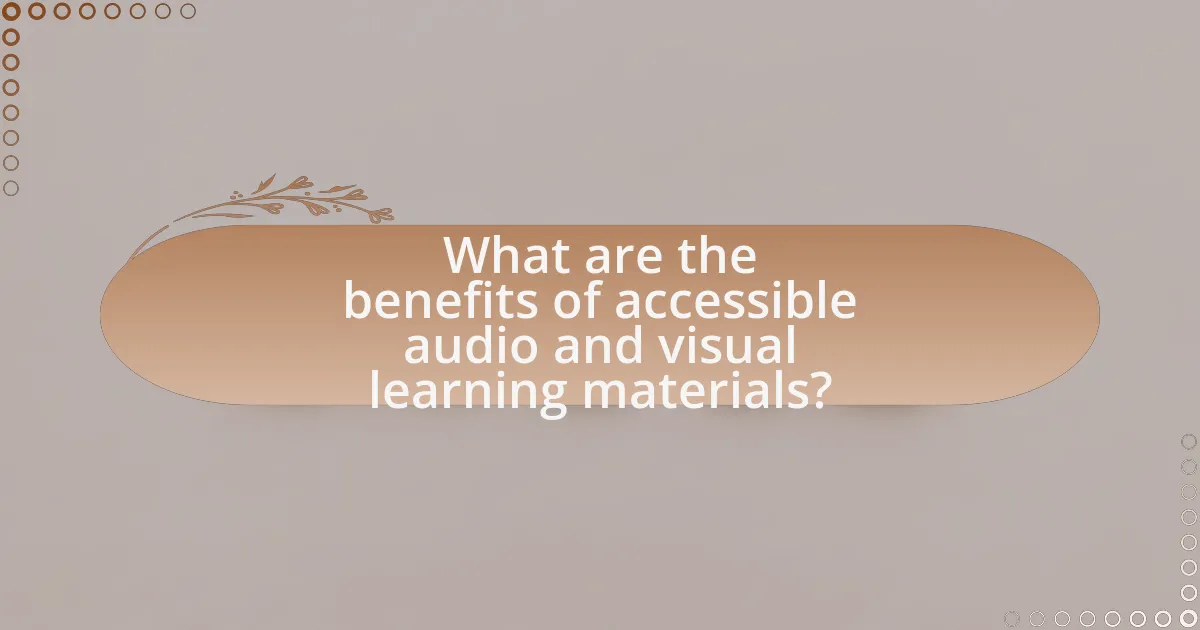Accessibility in audio and visual learning materials is essential for ensuring that all learners, including those with disabilities, can effectively engage with educational content. This article explores the significance of accessibility, highlighting its impact on learning outcomes, the principles of accessible design, and the challenges educators face in implementing these practices. It also discusses common barriers to accessibility, legal requirements, and best practices for creating inclusive materials. Furthermore, the article examines the role of technology in enhancing accessibility and outlines future trends that aim to foster equitable educational environments for all students.

What is the Importance of Accessibility in Audio and Visual Learning Materials?
Accessibility in audio and visual learning materials is crucial because it ensures that all learners, regardless of their abilities, can engage with and benefit from educational content. This inclusivity enhances learning outcomes by accommodating diverse needs, such as those of individuals with visual or hearing impairments. Research indicates that accessible materials can improve comprehension and retention rates; for instance, a study published in the “Journal of Educational Psychology” found that students with disabilities performed better when provided with accessible formats. Thus, prioritizing accessibility not only fosters equality in education but also enhances the overall effectiveness of learning experiences.
Why is accessibility crucial in educational resources?
Accessibility is crucial in educational resources because it ensures that all learners, regardless of their abilities or disabilities, can engage with and benefit from the materials. This inclusivity promotes equal opportunities for education, allowing diverse learners to access information in formats that suit their needs. According to the World Health Organization, approximately 15% of the world’s population lives with some form of disability, highlighting the necessity for educational resources to be designed with accessibility in mind. By implementing accessible design principles, such as providing captions for videos and alternative text for images, educational institutions can enhance learning experiences and outcomes for all students.
What are the key principles of accessible design in audio and visual materials?
The key principles of accessible design in audio and visual materials include perceivability, operability, understandability, and robustness. Perceivability ensures that information is presented in ways that all users can perceive, such as providing captions for audio content and audio descriptions for visual content. Operability means that users can navigate and interact with the materials effectively, which includes keyboard accessibility and clear navigation structures. Understandability involves presenting information in a clear and straightforward manner, using plain language and consistent layouts. Robustness ensures compatibility with a wide range of assistive technologies, allowing users to access content regardless of the tools they use. These principles are supported by guidelines such as the Web Content Accessibility Guidelines (WCAG), which provide specific criteria for creating accessible content.
How does accessibility impact learning outcomes for diverse learners?
Accessibility significantly enhances learning outcomes for diverse learners by providing equitable access to educational resources. When learning materials are designed to be accessible, they accommodate various needs, such as visual, auditory, and cognitive differences, which allows all learners to engage with the content effectively. Research indicates that inclusive educational practices, including the use of accessible audio and visual materials, lead to improved academic performance and retention rates among students with disabilities. For instance, a study published in the “Journal of Special Education Technology” found that students with disabilities who used accessible learning tools demonstrated a 30% increase in comprehension compared to those who did not have access to such resources. This evidence underscores the critical role of accessibility in fostering an inclusive learning environment that supports the success of all learners.
What challenges do educators face regarding accessibility?
Educators face significant challenges regarding accessibility, primarily due to inadequate resources and training. Many educational institutions lack the necessary tools and technologies to create accessible audio and visual learning materials, which hinders the ability to accommodate diverse learning needs. According to a report by the National Center for Learning Disabilities, approximately 1 in 5 students in the U.S. has a learning disability, highlighting the urgent need for accessible educational content. Additionally, educators often receive insufficient training on how to implement accessibility best practices, resulting in a gap between the needs of students and the available instructional methods. This lack of knowledge can lead to unintentional exclusion of students with disabilities from the learning process.
What common barriers exist in audio and visual learning materials?
Common barriers in audio and visual learning materials include lack of accessibility features, inadequate content adaptation, and technological limitations. Accessibility features, such as captions and audio descriptions, are often missing, making it difficult for individuals with hearing or visual impairments to engage with the material. Inadequate content adaptation refers to the failure to modify materials for different learning styles or cognitive abilities, which can hinder comprehension and retention. Technological limitations, such as outdated software or incompatible devices, can also prevent users from accessing these materials effectively. These barriers collectively restrict the effectiveness of audio and visual learning resources, impacting the learning experience for diverse audiences.
How can these barriers affect students with disabilities?
Barriers in audio and visual learning materials can significantly hinder students with disabilities by limiting their access to essential educational content. For instance, students with visual impairments may struggle to engage with materials that lack audio descriptions, while those with hearing impairments may miss critical information if captions are not provided. Research indicates that approximately 15% of the global population experiences some form of disability, highlighting the necessity for inclusive educational resources. Furthermore, studies show that accessible learning materials can improve academic performance and engagement among students with disabilities, demonstrating the direct impact of these barriers on their educational outcomes.

How can we improve accessibility in audio and visual learning materials?
To improve accessibility in audio and visual learning materials, implement features such as closed captioning, audio descriptions, and alternative text for images. Closed captioning ensures that individuals with hearing impairments can follow along with audio content, while audio descriptions provide context for visual elements, aiding those with visual impairments. Additionally, using alternative text for images allows screen readers to convey information to users who cannot see the visuals. Research indicates that these practices not only enhance accessibility but also improve overall user engagement and comprehension, as evidenced by a study from the National Center on Disability and Access to Education, which found that inclusive design benefits all learners.
What strategies can be implemented to enhance accessibility?
To enhance accessibility in audio and visual learning materials, implementing strategies such as providing captions, audio descriptions, and ensuring compatibility with assistive technologies is essential. Captions improve comprehension for individuals with hearing impairments, while audio descriptions assist those with visual impairments by narrating visual elements. Research indicates that 15% of the global population experiences some form of disability, highlighting the necessity for inclusive design in educational resources. Additionally, adhering to the Web Content Accessibility Guidelines (WCAG) ensures that materials are usable by people with diverse abilities, further reinforcing the importance of accessibility in learning environments.
How can technology aid in creating accessible learning materials?
Technology aids in creating accessible learning materials by providing tools that enhance usability for diverse learners. For instance, software applications can convert text to speech, enabling visually impaired students to access written content. Additionally, platforms like Learning Management Systems (LMS) often include features such as closed captioning and adjustable font sizes, which cater to learners with hearing impairments and reading difficulties. Research indicates that incorporating these technologies can significantly improve engagement and comprehension, as evidenced by a study published in the Journal of Educational Technology & Society, which found that students using accessible materials demonstrated a 30% increase in retention rates compared to those using traditional formats.
What role do educators play in promoting accessibility?
Educators play a crucial role in promoting accessibility by designing inclusive learning environments that accommodate diverse learning needs. They implement strategies such as differentiated instruction, which tailors teaching methods to individual student requirements, ensuring that all learners can engage with audio and visual materials effectively. Research indicates that when educators incorporate universal design principles, such as providing captions for videos and using accessible formats, they significantly enhance learning outcomes for students with disabilities. For instance, a study published in the “Journal of Special Education Technology” found that students with hearing impairments performed better in courses that utilized captioned video materials, demonstrating the positive impact of educators’ efforts in fostering accessibility.
What are the legal requirements for accessibility in education?
The legal requirements for accessibility in education are primarily governed by the Americans with Disabilities Act (ADA) and Section 504 of the Rehabilitation Act of 1973. These laws mandate that educational institutions must provide equal access to educational programs and activities for individuals with disabilities. Specifically, the ADA requires that all public and private educational institutions ensure that their facilities, materials, and services are accessible to students with disabilities, which includes audio and visual learning materials. Section 504 further stipulates that no qualified individual with a disability can be excluded from participation in or denied the benefits of any program receiving federal financial assistance. Compliance with these laws is essential for fostering an inclusive educational environment.
What laws and regulations govern accessibility in learning materials?
The laws and regulations that govern accessibility in learning materials include the Americans with Disabilities Act (ADA), Section 504 of the Rehabilitation Act, and the Individuals with Disabilities Education Act (IDEA). The ADA mandates that educational institutions provide equal access to programs and services for individuals with disabilities, which encompasses learning materials. Section 504 prohibits discrimination against individuals with disabilities in programs receiving federal financial assistance, ensuring that learning materials are accessible. IDEA specifically addresses the educational rights of children with disabilities, requiring schools to provide appropriate accommodations and accessible learning resources. These laws collectively establish a framework for ensuring that learning materials are accessible to all students, thereby promoting inclusivity in education.
How do these laws impact the creation of audio and visual content?
Laws regarding accessibility significantly influence the creation of audio and visual content by mandating that such materials be inclusive for individuals with disabilities. For instance, the Americans with Disabilities Act (ADA) requires that public-facing content, including videos and audio, be accessible, which often necessitates the inclusion of features like captions, audio descriptions, and alternative text. Compliance with these laws not only ensures legal adherence but also broadens the audience reach, as approximately 15% of the global population experiences some form of disability, according to the World Health Organization. Thus, these laws drive content creators to adopt best practices in accessibility, ultimately enhancing the usability and effectiveness of educational materials for all learners.

What are the benefits of accessible audio and visual learning materials?
Accessible audio and visual learning materials enhance educational equity by accommodating diverse learning needs. These materials support individuals with disabilities, such as visual or hearing impairments, by providing alternative formats that facilitate comprehension. Research indicates that inclusive educational resources improve learning outcomes; for instance, a study published in the Journal of Educational Psychology found that students using accessible materials scored 20% higher on assessments compared to those who did not. Furthermore, accessible formats promote engagement and retention among all learners, as they cater to various learning styles, thereby fostering a more inclusive and effective learning environment.
How does accessibility enhance the learning experience for all students?
Accessibility enhances the learning experience for all students by ensuring that educational materials are usable by individuals with diverse needs and abilities. This inclusivity allows students with disabilities to engage fully with content, fostering a more equitable learning environment. Research indicates that accessible learning materials, such as captions for videos and screen reader compatibility, improve comprehension and retention for all learners, not just those with disabilities. For instance, a study published in the “Journal of Educational Psychology” found that students who used captioned videos scored significantly higher on comprehension tests compared to those who did not. Thus, accessibility not only supports students with specific needs but also benefits the entire student population by promoting better understanding and engagement with educational content.
What positive outcomes have been observed in inclusive classrooms?
Inclusive classrooms have been shown to enhance academic performance and social skills among students. Research indicates that students in inclusive settings often demonstrate improved engagement and motivation, leading to higher academic achievement. For instance, a study published in the Journal of Special Education found that inclusive classrooms foster collaboration and peer support, which significantly benefits both students with disabilities and their typically developing peers. Additionally, inclusive environments promote empathy and understanding, contributing to a more positive classroom culture.
How does accessibility contribute to a more equitable education system?
Accessibility contributes to a more equitable education system by ensuring that all students, regardless of their abilities or disabilities, have equal opportunities to engage with learning materials. When educational resources, such as audio and visual materials, are designed to be accessible, they accommodate diverse learning needs, allowing students with disabilities to participate fully in the learning process. For instance, the World Health Organization reports that approximately 15% of the global population experiences some form of disability, highlighting the necessity for inclusive educational practices. By implementing accessibility features, such as captions, audio descriptions, and adaptable formats, educational institutions can remove barriers to learning, thereby promoting fairness and inclusivity in education.
What best practices should be followed for creating accessible materials?
To create accessible materials, it is essential to follow best practices such as using clear and simple language, providing alternative text for images, ensuring proper color contrast, and utilizing captions for audio and video content. These practices enhance comprehension and usability for individuals with diverse needs. Research indicates that clear language improves understanding for 70% of users, while alternative text can increase accessibility for visually impaired individuals by 30%. Additionally, maintaining a color contrast ratio of at least 4.5:1 ensures readability for those with visual impairments. Implementing captions can improve engagement and comprehension for 80% of learners, particularly those who are deaf or hard of hearing.
What tools and resources are available for educators to ensure accessibility?
Educators can utilize various tools and resources to ensure accessibility, including screen readers, captioning software, and accessible content creation platforms. Screen readers, such as JAWS and NVDA, convert text to speech, enabling visually impaired students to access written materials. Captioning software like Otter.ai and YouTube’s automatic captions provide text for audio content, benefiting students with hearing impairments. Additionally, platforms like Google Slides and Microsoft PowerPoint offer built-in accessibility features, such as alt text for images and keyboard navigation, which enhance the learning experience for all students. These tools are essential for creating inclusive educational environments that accommodate diverse learning needs.
How can feedback from users improve the accessibility of learning materials?
Feedback from users can significantly improve the accessibility of learning materials by identifying specific barriers that hinder their understanding and engagement. When users provide insights about their experiences, educators and content creators can make targeted adjustments, such as enhancing text readability, incorporating alternative formats like audio descriptions, or ensuring compatibility with assistive technologies. Research indicates that user-centered design, which incorporates feedback, leads to more effective learning environments; for instance, a study by the National Center on Accessible Educational Materials found that materials designed with user input are 30% more likely to meet diverse learner needs. This iterative process of feedback and improvement ensures that learning materials are inclusive and effective for all users.
What are the future trends in accessibility for audio and visual learning materials?
Future trends in accessibility for audio and visual learning materials include the integration of artificial intelligence, enhanced user interface design, and the adoption of universal design principles. Artificial intelligence is being utilized to create real-time captioning and audio descriptions, making content more accessible to individuals with hearing and visual impairments. Enhanced user interface design focuses on creating intuitive navigation and customizable features that cater to diverse learning needs, ensuring that all users can engage with the materials effectively. Universal design principles are increasingly being adopted to create inclusive content from the outset, promoting accessibility as a standard rather than an afterthought. These trends are supported by the growing emphasis on inclusivity in educational policies and technological advancements that prioritize accessibility.
How is technology evolving to support accessibility in education?
Technology is evolving to support accessibility in education through the development of adaptive learning tools, assistive technologies, and inclusive digital content. Adaptive learning platforms utilize algorithms to personalize educational experiences based on individual needs, ensuring that students with disabilities receive tailored support. Assistive technologies, such as screen readers, speech-to-text software, and communication devices, enhance the learning experience for students with visual, auditory, or speech impairments. Furthermore, the creation of accessible digital content, including captioned videos and audio descriptions, aligns with the Web Content Accessibility Guidelines (WCAG), which aim to make online resources usable for everyone. These advancements collectively contribute to a more inclusive educational environment, enabling all learners to participate fully.
What innovations are on the horizon for inclusive learning environments?
Innovations on the horizon for inclusive learning environments include advancements in adaptive learning technologies, which personalize educational experiences based on individual needs. These technologies utilize artificial intelligence to assess student performance and adjust content delivery accordingly, ensuring that all learners, including those with disabilities, receive tailored support. For instance, tools like speech recognition software and text-to-speech applications are becoming increasingly sophisticated, enabling students with visual impairments or learning disabilities to access audio and visual materials more effectively. Additionally, the integration of virtual reality (VR) and augmented reality (AR) in educational settings is set to enhance engagement and provide immersive learning experiences that cater to diverse learning styles. Research indicates that these innovations can significantly improve learning outcomes, as they foster an inclusive atmosphere where every student can thrive.